 |
| Recent Press
Releases > Plasmacluster Ions® Proven Effective Against
Airborne Highly Pathogenic H5N1 Avian Influenza |
 |
 |
 |
June 6, 2005 |
 |
Plasmacluster Ions®*1 Proven Effective
Against Airborne Highly Pathogenic H5N1 Avian Influenza
A World First Among Air Purification Technologies*2
|
 |
Sharp Corporation has demonstrated that Plasmacluster
Ions reduce activity of the highly fatal and highly pathogenic
airborne H5N1 avian influenza (“bird flu”) virus
by 99%. This research was conducted in collaboration with
Retroscreen Virology, Ltd., an organization which was established
by one of the world’s leading authorities on virology,
Professor John S. Oxford of the University of London School
of Medicine & Dentistry, and which works in compliance
with Good Laboratory Practice*3 (GLP). Among the diverse range
of air purification technologies available, Plasmacluster
Ions are the first in the world to have been proven effective
against this virus.
Plasmacluster Ion technology was developed in 2000 and is
an air purification technology that disables airborne microorganisms
by releasing positive and negative ions into the air. In the
five years since its development, Sharp has been working together
with academic research organizations around the world based
on a “collaborative research approach to product marketing*4”
and has demonstrated that Plasmacluster Ions are effective
against a total of 26 kinds of harmful airborne substances,
including bacteria, mold fungi, viruses and allergens. In
addition, in November 2004, the mechanism by which Plasmacluster
Ions cause cell death was explained: they damage the proteins
on the cell membrane surface of bacteria. It has now been
proven scientifically that they have the potential to be effective
against a broad array of harmful airborne substances that
have proteins on their cell surfaces.
The type of avian influenza virus for which effectiveness
has most recently been confirmed is the highly pathogenic
H5N1 avian influenza virus, which has in fact taken a toll
on human life. This research finding confirms that Plasmacluster
Ions are effective against newly emerging viruses and has
further expanded the fields in which Plasmacluster Ions demonstrate
efficacy.
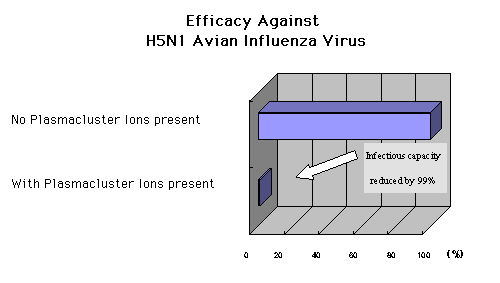
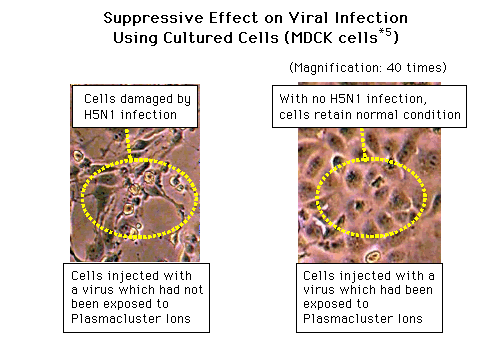
| *1 |
Plasmacluster and Plasmacluster Ions
are trademarks of Sharp Corporation. |
| *2 |
As of June 6, 2005 |
| *3 |
In the OECD (Organization for Economic
Co-operation and Development), Good Laboratory Practice
is a set of standards intended to ensure the reliability
of test results by reviewing operation management, test
equipment, test design, internal audit controls, quality
assurance systems, test results, etc., at all test facilities.
Re-certification is required every three years. |
| *4 |
The “collaborative research
approach to product marketing” verifies the effectiveness
of a technology based on scientific data developed in
collaboration with leading-edge academic research institutions.
New products are then brought to market based on the
results. |
| *5 |
Canine kidney cells |
Virus infection test using cultured cells
A Plasmacluster Ion Generator was placed in a box with a volume
of one (1) m3, and Plasmacluster Ions were generated (concentration:
7000 ions/cm3). Then, aerosolized highly pathogenic avian
influenza virus was sprayed into the box. Five minutes after
the spraying was complete, the air in the box containing the
airborne virus was sampled at 10-minute intervals. The virus
was then extracted and injected into cell cultures. Changes
in the cells were then observed over a four-day period.
Four days after injection, the cells injected with the virus
that had not been exposed to Plasmacluster Ions were deformed
and damaged. In contrast, cells injected with the virus that
had been exposed to Plasmacluster Ions retained their normal
condition with almost no change in evidence.
From this, it was confirmed that Plasmacluster Ions can reduce
the activity of the virus by 99%. (The TCID50 [Tissue Culture
Infectious Dose 50%] assay, which is widely used in the field
of virology, was used to evaluate the test results.)
Observation
photographs of cells (MDCK cells) injected with virus
samples |
Cells injected with
virus sample
not exposed to Plasmacluster Ions |
|
Cells injected with
virus sample exposed to Plasmacluster Ions |
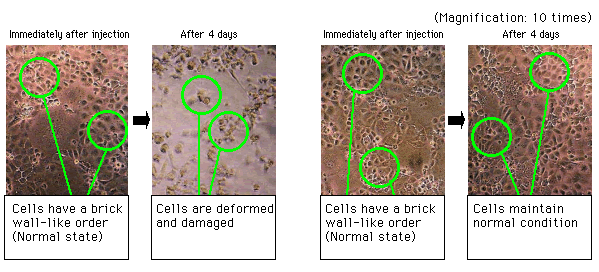
Analysis of cell antibodies with the Fluorescent Antibody
Technique
Both the virus samples, those exposed to Plasmacluster Ions
and those not, were injected into cells and the cell reaction
to the viral infection was evaluated. This examination was
conducted using the Fluorescent Antibody Technique, a standard
method in the field of virus research. The technique involves
dyeing cells with fluorescence to identify whether or not
the cell is infected; if the cell has been infected by the
virus, it will radiate.
In cells injected with the virus “not exposed”
to Plasmacluster Ions, fluorescent coloring indicative of
a viral infection was present. And, in contrast, the coloring
was not present in cells injected with the virus “exposed”
to Plasmacluster Ions. From this analysis, the virus sampled
in the presence of Plasmacluster Ions was verified to have
lost its capacity for infection.
Fluorescent
coloring photograph of
cells (MDCK cells) injected with virus samples |
Injected with a virus
sample
not exposed to Plasmacluster Ions |
|
Injected with a virus
sample exposed to Plasmacluster Ions |
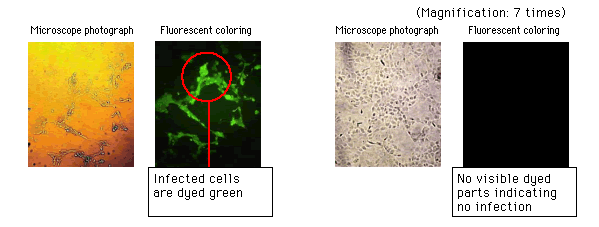
About Highly Pathogenic Avian Influenza (“Bird
Flu”)
Various types of influenza virus are classified according
to two types of “spikes” on the virus surface
(H: hemagglutinin and N: neuraminidase), and among these,
viruses that infect poultry and cause illness and death are
well known, such as H5N1, H7N7, H9N2, etc.
In contrast to mildly pathogenic influenza viruses which infect
and proliferate only in the respiratory organs and intestinal
tract and whose symptoms remain relatively minor, highly pathogenic
influenza viruses infect and multiply throughout the entire
body. In poultry, the mortality rate approaches 100%.
Since 1997, avian influenza has taken a tremendous toll on
poultry in Hong Kong, the Netherlands, Vietnam, Cambodia,
Thailand, Korea and Japan. Furthermore, in Vietnam, Cambodia
and Thailand, its transmission to humans, who were previously
not considered susceptible, has been confirmed with the occurrence
of 97 patient cases and 53 deaths*6. This current
research proves the efficacy of Plasmacluster Ions on the
highly pathogenic H5N1 avian influenza virus, which has in
fact taken a toll on human life.
| *6 |
As of May 19, 2005; according to
a news release from the World Health Organization (WHO). |
Overview of Plasmacluster Ion Technology
A plasma discharge generates positive ions (H+)
and negative ions (O2–) from water
vapor in the air. These ions have the property of clustering
around microparticles, and thus, they surround harmful substances
such as airborne mold, viruses and allergens. At that point,
a chemical reaction occurs on the cell membrane surface, and
they are transformed into OH radicals, a powerfully active
but unstable material, which robs the harmful substance of
a hydrogen atom (H). As a result, they are inactivated by
severing the protein on the cell membrane, opening holes.
The OH radicals instantly bond with the removed hydrogen (H),
forming water vapor (H2O), and return to the air.
| 1) |
The Plasmacluster Ions are the same positive
and negative ions found in abundance in nature, for
example, in woods and forests. They turn into OH radicals
only on the surface of harmful substances to inactivate
them, so they are completely harmless to the human body.
The amount of ozone generated is less than 0.01 ppm,
significantly below the 0.05-ppm value set as the standard
for industry and for electrical equipment. |
| 2) |
Compared to passive air cleaning systems
that trap airborne contaminants by using a fan to draw
air through a filter, air purification systems based
on Plasmacluster Ions effectively eliminate bacteria
by working directly on the air contained in the entire
room. |
| 3) |
The Plasmacluster Ion Generator never
loses its effectiveness by becoming dirty and never
needs replacing like filters. It consumes a miniscule
amount of electricity (0.5 W). Annual electricity costs
for continuous use are around ¥100. |
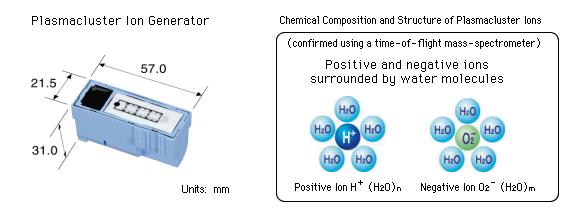
Efficacy of Plasmacluster Ions on Various Pathogens Confirmed
Through Collaborative Research
Target Substance |
Species |
Testing & Verification Organization |
Date of Announcement |
| Fungi |
Cladosporium (black mold, mildew) |
Ishikawa Health Service Association |
September 2000 |
| Universitäklinikums Lübeck University Clinic
(Germany) (proliferation control effect) |
February 2002 |
| CT&T (Professor Gerhard Artmann, Aachen University
of Applied Sciences) |
November 2004 |
| Penicillium, Aspergillus |
Universitäklinikums Lübeck University Clinic
(Germany) (proliferation control effect) |
February 2002 |
| Aspergillus, Penicillium (two species), Stachybotrys,
Alternaria, Mucorales |
CT&T (Professor Gerhard Artmann, Aachen University
of Applied Sciences) |
November 2004 |
| Bacteria |
Coliform bacteria (E. coli) |
Ishikawa Health Service Association |
September 2000 |
| E. coli, Staphylococcus (aureus), Candida |
Shanghai Municipal Center for Disease Control and
Prevention, China |
October 2001 |
| Bacillus subtilis |
Kitasato Research Center of Environmental Sciences |
September 2002 |
| CT&T (Professor Gerhard Artmann, Aachen University
of Applied Sciences) |
November 2004 |
| MRSA (methicillin-resistant Staphylococcus
aureus) |
Kitasato Research Center of Environmental Sciences |
September 2002 |
| Kitasato Institute Medical Center Hospital |
February 2004 |
| Pseudomonas, Enterococcus, Staphylococcus |
Universitäklinikums Lübeck University Clinic
(Germany) |
February 2002 |
| Enterococcus, Staphylococcus, Sarcina, Micrococcus |
CT&T (Professor Gerhard Artmann, Aachen University
of Applied Sciences) |
November 2004 |
| Allergens |
Mite allergen (dust from dead mite bodies and feces),
pollen |
Graduate School of Advanced Sciences of Matter, Hiroshima
University |
September 2003 |
| Airborne allergens |
Asthma Society of Canada |
April 2004 |
| Viruses |
H1N1 influenza virus |
Kitasato Research Center of Environmental Sciences |
September 2002 |
| Seoul University, Korea |
September 2003 |
| Shanghai Municipal Center for Disease Control and
Prevention, China |
December 2003 |
| Kitasato Institute Medical Center Hospital |
February 2004 |
| H5N1 avian influenza virus |
Retroscreen Virology, Ltd, London, U.K. |
May 2005 |
| Coxsackie virus (summer colds) |
Kitasato Research Center of Environmental Sciences |
September 2002 |
| Polio virus |
Kitasato Research Center of Environmental Sciences |
September 2002 |
| Corona virus |
Kitasato Institute Medical Center Hospital |
July 2004 |
Profile of Professor John S. Oxford
| • |
World authority on virology |
| • |
Professor, Institute of Cell and Molecular
Science at St. Bartholomew's and The Royal London Hospital,
Queen Mary's School of Medicine and Dentistry, London,
U.K. |
| • |
Founder and Scientific Director, Retroscreen
Virology Ltd., |
Expertise
Virology
Publications
| • |
Published over 250 scientific papers |
| • |
Co-authored three standard texts:
1) Influenza, the Viruses and the Disease
2) Human Virology, a Text for Students of Medicine,
Dentistry and Microbiology
3) Conquest of Viral Diseases |
Other Professional Activities
| • |
Appeared on numerous radio and TV programs
(BBC, National Geographic, etc.) |
| • |
Served as chairman of numerous international
scientific and academic conferences |
Conferences where Prof. Oxford will serve as Chairman in the
near future:
| 1) |
Second European Conference on Influenza,
September 2005, Malta |
| 2) |
Optimizing Antiviral Drug Therapy Symposium,
October 2005, Berlin |
| 3) |
The Central Role of Antivirals for the
First Pandemic of the 21st Century, January 2006, London |
About the University of London
Established in 1836 as England’s national university,
the University of London consists of 19 colleges with a total
of 115,000 students, one of the largest student bodies in
the world.
Queen Mary is one of the largest multi-faculty colleges of
the University of London. Queen Mary merged with two distinguished
medical colleges, St Bartholomew’s Hospital Medical
College, established in 1843, and the London Hospital Medical
College, England's oldest medical school, founded in 1785,
to form the School of Medicine & Dentistry. With nearly
8,800 students, the School provides education in a wide range
of fields in addition to medicine and dentistry, including
biology, chemistry, physics, electrical engineering, computer
science, law, literature, and political science.
Dinstinguished Graduates
Alexander Graham Bell, Hirofumi Ito (first prime minister
of Japan), John F. Kennedy, Mahatma Gandhi, H.G. Wells, Arthur
C. Clarke; seven Nobel Prize winners.
About Retroscreen Virology, Ltd.
Founded in 1989 by Professor John Oxford, Retroscreen Virology
Ltd. is a recognized leader in the research and testing of
antiviral compounds and vaccines. In carrying out safety tests
of chemical substances, the company works to extremely high
standards in compliance with the principles of Good Laboratory
Practice (GLP), an international management standard for maintaining
high reliability, and has obtained accreditation under the
quality control management standard ISO 9001.
Reference
Mechanism of Plasmacluster Ion for Inactivating Harmful Substances
Mechanism for Inactivating Airborne Fungi
The positive (H+) and negative (O2-)
ions cluster together on the surface of airborne fungi, causing
a chemical reaction that results in the creation of highly
reactive OH groups called hydroxyl radicals (•OH). The
hydroxyl radical will take a hydrogen molecule from the cell
wall of an airborne fungi particle. Inhibits mold infestation
as well as controls musty and household odors (caused in large
part by mold fungi) as they occur.
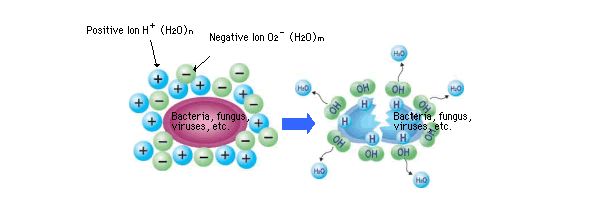
Mechanism for Inactivating Airborne Virus
The positive (H+) and negative (O2-)
ions surround the hemagglutinin (surface proteins that form
on organisms and trigger infections) and change into highly
reactive OH groups called hydroxyl radicals (•OH). These
take a hydrogen molecule from the hemagglutinin and change
into water (H2O). The ions destroy the virus surface
structure, for example its envelopes and spikes, on a molecular
level. As a result, the virus cannot infect even if it enters
the body.
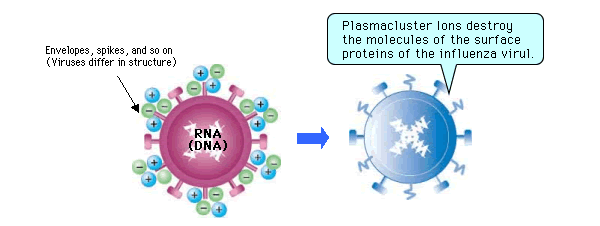
Mechanism for Deactivating Airborne Allergens
The positive (H+) and negative (O2-)
ions surround the airborne allergen and change into highly
reactive hydroxyl radicals (•OH). The hydroxyls then
deactivate the molecules of the IgE antibody binding site
of the allergen. No allergic symptoms occur even if allergens
enter the body.
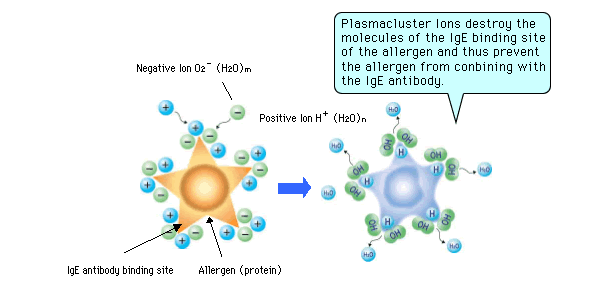
|
|
 |
The following information is true and accurate at the time of publication. Manufacture,
sale, price and specifications of products may be subjected to change.
|
| Press contact: |
Sharp Corporation
Public Relations Division
Osaka: 81-6-6621-1272 Tokyo: 81-3-3260-1870 |
|
|
|
| Recent Press
Releases > Plasmacluster Ions® Proven Effective
Against Airborne Highly Pathogenic H5N1 Avian Influenza |
 |
|